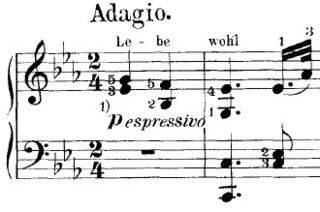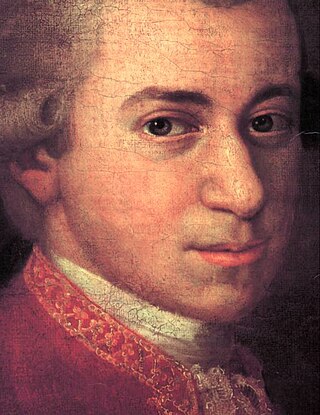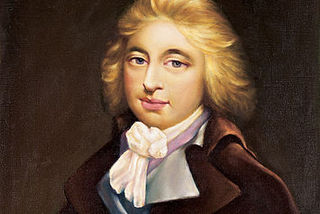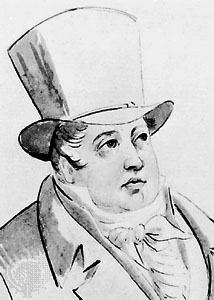The two Serenades, Op. 11 and 16, represent early efforts by Johannes Brahms to write orchestral music. They both date from after the 1856 death of Robert Schumann when Brahms was residing in Detmold and had access to an orchestra.

Ludwig van Beethoven's Piano Sonata No. 26 in E♭ major, Op. 81a, known as Les Adieux, was written during the years 1809 and 1810. This sonata was influenced by Jan Ladislav Dussek's sonata with the same nickname.
The Piano Sonata No. 19 in G minor, Op. 49, No. 1, and Piano Sonata No. 20 in G major, Op. 49, No. 2, are short sonatas by Ludwig van Beethoven, published in 1805. Both works are approximately eight minutes in length, and are split into two movements. These sonatas are referred to as the Leichte Sonaten to be given to his friends and students.
The String Quintet No. 4 in G minor, K. 516, written by Wolfgang Amadeus Mozart, is like all of Mozart's string quintets a "viola quintet" in that it is scored for string quartet and an extra viola . The mood of the piece is dark and melancholic, typical of Mozart's G minor works.

The Serenade No. 10 for winds in B-flat major, K. 361/370a, is a serenade by Wolfgang Amadeus Mozart scored for thirteen instruments: twelve winds and string bass. The piece was probably composed in 1781 or 1782 and is often known by the subtitle Gran Partita, though the title is a misspelling and not in Mozart's hand. It consists of seven movements.
Hyacinthe Jadin was a French composer who came from a musical family. His uncle Georges Jadin was a composer in Versailles and Paris, along with his father Jean Jadin, who had played bassoon for the French Royal Orchestra. He was one of five musical brothers, the best known of whom was Louis-Emmanuel Jadin.
The six String Quartets, Op. 76, by Joseph Haydn were composed in 1797 or 1798 and dedicated to the Hungarian count Joseph Georg von Erdődy (1754–1824). They form the last complete set of string quartets that Haydn composed. At the time of the commission, Haydn was employed at the court of Prince Nicolaus Esterházy II and was composing the oratorio The Creation as well as Princess Maria Hermenegild Esterházy's annual mass.
The Op. 33 String Quartets were written by Joseph Haydn in the summer and Autumn of 1781 for the Viennese publisher Artaria. This set of string quartets has several nicknames, the most common of which is the "Russian" quartets, because Haydn dedicated the quartets to the Grand Duke Paul of Russia and many of the quartets were premiered on Christmas Day, 1781, at the Viennese apartment of the Duke's wife, the Grand Duchess Maria Feodorovna. Some scholars theorize that the "Russian" quartets were the inspiration for Mozart's six string quartets dedicated to Haydn, but no direct evidence has been found.
An organ concerto is a piece of music, an instrumental concerto for a pipe organ soloist with an orchestra. The form first evolved in the 18th century, when composers including Antonio Vivaldi, George Frideric Handel and Johann Sebastian Bach wrote organ concertos with small orchestras, and with solo parts which rarely call for the organ pedal board. During the Classical period the organ concerto became popular in many places, especially in Bavaria, Austria and Bohemia, reaching a position of being almost an integral part of the church music tradition of jubilus character. From the Romantic era fewer works are known. Finally, there are some 20th- and 21st-century examples, of which the concerto by Francis Poulenc has entered the basic repertoire, and is quite frequently played.
The Piano Sonata in E minor D 566 by Franz Schubert is a sonata for solo piano written in June 1817. The Rondo D. 506 is most likely the fourth movement according to Martino Tirimo.
The Piano Sonata No. 2 in F♯ minor, Op. 2 of Johannes Brahms was written in Hamburg, Germany in 1852, and published the year after. Despite being his second published work, it was actually composed before his Piano Sonata No. 1 in C major, but was published later because Brahms recognized the importance of an inaugural publication and felt that the C major sonata was of higher quality. It was sent along with his first sonata to Breitkopf und Härtel with a letter of recommendation from Robert Schumann. Schumann had already praised Brahms enthusiastically, and the sonata shows signs of an effort to impress, with its technical demands and highly dramatic nature. It was dedicated to Clara Schumann.

Piano Trio No. 1 in D minor, Op. 32, for violin, cello and piano is a Romantic chamber composition by the Russian composer Anton Arensky. It was written in 1894 and is in four movements:
- Allegro moderato – Unlike the agitated opening melody of the first movement from Mendelssohn's Piano Trio No. 1, this piece opens gently, lyrically and elegiacally, setting an autumnal mood of the whole work. This movement ends with a coda marked "Adagio".
- Scherzo – The movement in the parallel key features flying notes, and a waltz-like middle section mainly in B-flat major. The movement is cheerful throughout.
- Elegia (Adagio) – Following the cheerful scherzo comes the contrasting and sad slow movement in the subdominant minor. Presenting no formal grief but memorial thoughts, this movement is deeply elegiac but not funereal. The middle section begins in G major but involves a number of key modulations, which makes the passage that initially evokes a brighter mood even more affecting yet dreamlike later on.
- Finale – Back in D minor, the movement opens dramatically. Later comes a recollection of themes from the third and first movements, which is followed by a turbulent ending that restates the primary theme of this movement.
String Quintet No. 2 in G major, Op. 111, is a work by Johannes Brahms composed in 1890 and published in 1891. It is known as the Prater Quintet. Brahms intended it to be his last piece of music, though he later produced a number of piano pieces and the two sonatas for clarinet or viola and piano. The first performance of the Quintet in Vienna on November 11, 1890 was a sensation.
The Violin Sonata No. 1 in G major, Op. 78, "Regensonate", for violin and piano was composed by Johannes Brahms during the summers of 1878 and 1879 in Pörtschach am Wörthersee. It was first performed on 8 November 1879 in Bonn, by the husband and wife Robert Heckmann (violin) and Marie Heckmann-Hertig (piano).
Sonatas, duos and fantasies by Franz Schubert include all works for solo piano by Franz Schubert, except separate dances. They also include a number of works for two players: piano four hands, or piano and a string instrument.

The String Quartets, Op. 50, were composed by Joseph Haydn in 1787. The set of six quartets was dedicated to King Frederick William II of Prussia. For this reason the set is commonly known as the Prussian Quartets. Haydn sold the set to the Viennese firm Artaria and, without Artaria's knowledge, to the English publisher William Forster. Forster published it as Haydn's Opus 44. Haydn's autograph manuscripts for Nos. 3 to 6 of the set were discovered in Melbourne, Australia, in 1982.
The Divertimento No. 17 in D major, K. 334/320b was composed by Wolfgang Amadeus Mozart between 1779 and 1780 and was possibly composed for commemorating the graduation of a close friend of Mozart's, Georg Sigismund Robinig, from his law studies at the University of Salzburg in 1780. Lasting about 42 minutes, it is the longest of the divertimenti by Mozart.

Jan Ladislav Dussek's Piano Sonata No. 18 in E♭ major, Op. 44, known as Les Adieux, was written and published in 1800. It was dedicated to Dussek's fellow composer and virtuoso pianist, Muzio Clementi. This sonata is the longest of Dussek's piano sonatas. This sonata had a major influence on Ludwig van Beethoven's sonata with the same nickname.






